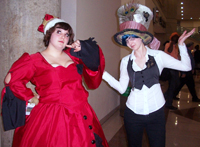
Librarian hat off; fan hat on! The Friday of NYCC is the first official day of the “con,” which means a lot more people and a lot more panels. Today I indulged in more of the fan aspect of NYCC, but one presentation—a history of the Comic Book Legal Defense Fund—caught the librarian eye.
Intellectual freedom fighters
Similar to ALA’s Office for Intellectual Freedom (and a partner with them on Banned Books Week), the Comic Book Legal Defense Fund (CBLDF) seeks to protect the First Amendment rights of those who create, distribute, and consume comics.
To understand CBLDF’s presence, one must take a brief look at the history of comics (some of which was mentioned from my Day 1 post). Shortly after World War II, author Sterling North wrote an anti-comics commentary in the Chicago Daily News, two years after the first Superman comics were published. North called comics “a poisonous mushroom growth of the last two years” and comic book publishers “guilty of a cultural slaughter of the innocents.” This attitude prevailed in the 1950s, with the publication of psychiatrist Fredric Wertham’s Seduction of the Innocent and hearings conducted by the Senate Judiciary Committee to investigate juvenile delinquency. Passionate defenses by the industry fell on deaf ears.
Realizing that the only options were self-censorship or go out of business, comic publishers created the Comics Code Authority. As a result, the 1960s saw the rise of underground comics and comic artists like R. Crumb—people who were ready, willing, and able to take on the status quo. In 1967, the courts deemed, for the first time, that a comic was legally obscene (R. Crumb’s Zap #4), and many comic retailers were convicted for selling comics (such as the New Yorker bookshop in New York City).
The 1970s weren’t any easier, particularly with the Supreme Court’s Miller v. California ruling, which set the obscenity test that is still used today. But, the 1970s also saw the rise of comic conventions, the comic shop as the specialty shop, more experimental and adult content, and international comics. The industry started to come back from the dark ages of the 1950s.
In the 1980s, comics fought back. After an employee of Friendly Frank’s comic shop in Lansing, Illinois, was arrested, comic publishers decided they have had enough. With a grassroots funding campaign they appealed the conviction and won. The leftover funds from that campaign founded CBLDF in 1990.
Today, CBLDF fights to protect not just comic books as a business but also comics as an art and a hobby. It fights on behalf of artists such as Florida artist Mike Diana, convicted on what was simply mistaken identity (some of his comics bore unintentional resemblance to an unsolved murder spree in Gainesville) and California artist Paul Mavrides. In Diana’s case, CBLDF was able to get his sentence commuted As for Mavrides, CBLDF helped him challenge a California law that would have levied a sales tax on comics.
Today, CBLDF continues to work side by side with creators and business owners, as well as libraries. (The librarian section of CBLDF’s website offers great resources for librarians, including a more detailed history of the censorship of comics and guides to graphic novel collection.) It is currently working to restore Matthew Loux’s graphic novel SideScrollers to the Enfield, Connecticut, school reading list after the district did not follow the proper materials challenge procedure. It also comes to the aid of readers, the most recent case being that of Ryan Matheson, a computer programmer arrested during a routine border search at the US‑Canada border for possession of a single questionable image on his computer. Thanks to CBLDF, the charges were dropped in March of this year.
If you find yourself in need of CBLDF’s services, you can call the nonprofit’s emergency hotline at 800-99-CBLDF. Executive Director Charles Brownstein has also appeared at ALA conferences (including the 2012 Annual Conference).
From the show floor and more…
Crowds, crowds and more crowds. It can be overwhelming but also fun. You can revel in the creativity of costumes. In particular, I love anything handcrafted. Being an active knitter and a cofounder of ALA’s own Craft Con, I appreciate the time and effort that goes in to anything made by hand. Here are two of several favorites:


Updated Oct. 17, 2012
KATE KOSTURSKI received her MLS from Pratt Institute and is currently the institutional participation coordinator (UK and Northern Europe) for JSTOR. She is a member of GameRT. Visit her at katekosturski.com,and follow her on Twitter at @librarian_kate.

